Introduction
Immigration to the islands is one of the greatest challenges facing Galápagos. Enforcing legislation restricting immigration to the islands is technically difficult, encourages the perception that Galápagos does not benefit the general populace of Ecuador, and could become a much more difficult job should the islands become an even more appealing place to live. To address this, we have examined each of these three points and worked to use each as a source of feedback guiding the choices made with respect to the village design. While the following proposal will suggest legislation and techniques for enforcement, it will be primarily devoted to understanding the incentives that naturally regulate the flow of people to and from the mainland, how our proposal will cause these to shift, and how this can be used both to benefit Galápagos and the mainland of Ecuador.
For the purpose of this report, baseline data will be drawn form the 1998 census carried out by INEC as it provides a consistent and easily accessible source of statistical information for the islands. Where other sources are available that report more current figures, or have made projections as to present numbers, these sources will be noted and used. The 1998 census reported the following population numbers:
Population Data
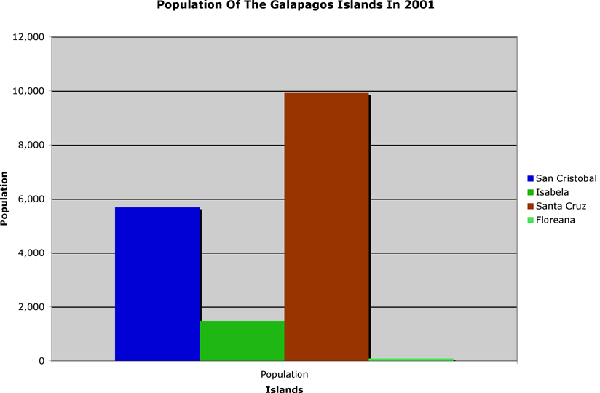
(Falconí, 2001)
Under the Special Law passed in 1998, permanent residence cards were provided to all permanent residents of Ecuador who were living on the islands when the Special Law was passed and have since remained for five years, individuals born on the islands to permanent residents, and those legally united through marriage with a permanent resident of the islands. Municiple employees and religious are also granted permanent residence cards under the Special Law, Article 63. Temporary residency guidelines are less defined, requiring that an employer recruit the applicant to fill an occupational niche impossible to fill with a current resident of Galápagos. In 2000, 1069 of just such job agreements were issued by INGALA. (Kerr et al., 2004) At present, employers are not responsible for the hire of illegal immigrants beyond the 30 times minimum wage fee paid to INGALA under Article 61 of the Special Law. (Kerr et al., 2004)
Under the Special Law, all residency cards for individuals who had lived on the islands for five years before the Special Law were requalified, a process that provides significant insights into current legal population numbers:
Permanent Requalified
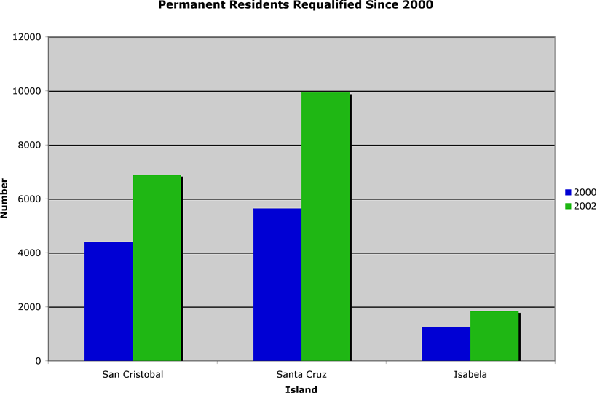
(Kerr et al., 2004)
While many sources contribute to population growth on the islands, migration is certainly one of the most powerful regulating force available. Average annual population increase as a percentage for the islands has been recorded by INEC to be relatively stable at just about 6% (Falconí, 2001).
Birth Rate
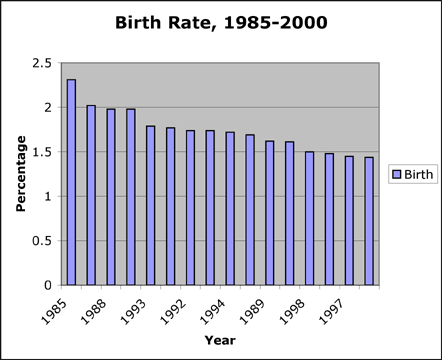
(Kerr et al., 2004)
[top]
Illegal Immigration
Illegal immigration to the islands must be stopped if the islands are to be settled in a sustainable fasion. There are currently two primary means of reaching the Galápagos in such a way that facilitates the illegal procurement of a permanent residence card. The first is by air either on a civilian, private, or military aircraft. Those who enter by air with TAME or AirGal are very often registered as tourists but then find a way to get around leaving a return ticket with INGALA. In each of these three cases, the weakest link allowing their entry is a fragmented number of entrance sites making the identification of all who enter the islands by air difficult. Of course in the case of private craft or military flights this same return ticket registration policy is impossible to enforce. In the second case, immigrants will enter the Marine Reserve on a cargo boat that in turn meets a smaller fishing vessel to take these individuals in to port. (Personal communication, C. Valle) While this trend has significantly decreased recently, private yachts or smaller fishing vessels have filled this void and will likely continue to do so to an even greater degree should entrance by air be better regulated. (Kerr et al., 2004) Ideally, each port is presently equipped to register tourists and residents arriving on the islands, but again this system is inconsistent. Once on land, such a person finds a family to stay with and vouch that this person has been on the islands for more than the alotted five years, thus making them eligible for permanent residence card. It is also possible to purchase a permanent residence card in some cases, although this has become significantly more difficult in recent years. Ecuadorian Indian populations can also illegally enter the Galapagos by “recycling” temporary permits to allow several relatives to come into the islands since the Indians find that it is difficult for Galapagos officials to distinguish among them easily based on their photos. (Kerr et al., 2004)
[top]
Population Increase due to Birth Rate
No matter how effective anti-immigration legislation is, the population on the island will naturally continue to expand. For the purposes of this report, we will pick an artificially high rate of 4% as the birth rate in order to ensure that the following plan maintains flexibility should the present younger generation remain on the islands and so cause this annual number to grow. This said, we acknowledge here that family size and birthrate on the islands have been falling over the last couple years and so hope to augment this trend. Indeed, birthrate on the islands is currently significantly lower than it is in other Ecuadorian provinces. (Falconí, 2001)
Birth Rates
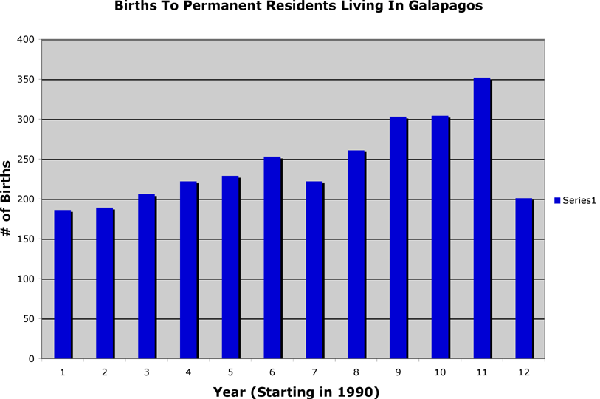
(Kerr et al., 2004)
This trend is positive in that it suggests that if immigration to the islands can be significantly restricted and other incentives implemented, it is realistic to envision a stable population size.
[top]
Legislation and Technical Changes
Presently, as suggested above, the infrastructure is not yet in place to successfully address the question of illegal immigrations. As rewriting or editing the Special Law is a particularly risky activity as it might cause other aspects of the Law to come under scrutiny, chaning the manner in which the Special Law is enforced provides the most immediate and realistic solution. (Kerr et al., 2004) INGALA’s current opperational budget for all immigration related activies stands at $250,000 and is thus not substantial enough to address all of these needs. (Kerr et al., 2004) Just as it is imperative that as SICGAL is strengthened, immigration regulation must also improved and centralized.
The most significant change we advocate with respect to village design in an attempt to remediate pressures associated with illegal immigration is a restructuring of how people enter and exit Galápagos. To do this, we advocate the construction of a floating airport below the southern tip of Isabela. By sending all air traffic through a highly speciallized, centralized system any infractions that occur or procedures skipped in either Quito or Guyaquil can be addressed. This same
floating island will be set up as a large docking station and provide a mandatory check point for all ships entering Galápagos. This will centralize all entry to the islands and thus make registration and implementation a much simpler, more reliable process. Ideally, those staffing this point of arrival should have limited ties with the island as they will be more likely to enfore the laws in an equitable manner. International volunteers with groups like the CDF would make exceptional candidates, and could be required to spens a certain percentage of their time on the islands learning about management strategies through direct participation with SICGAL and migratory law.
To support this system, and as part of the overal monitoring project to assess ecosystem health, we propose an automotated system that tracks all boats within the Marine Reserve. As articulated in the monitoring proposals, GPS tracking devices will be mounted on all boats, no matter their size or purpose in Galápagos. This satellite based tracking system will then match each boat in the Marine Reserve against a GPS signal. Where no signal is associated with a boat entering the marine reserve, an alert will be sent out and the boat tracked until it docks at the floating island. Should the boat approach an island, the local coastal patrol will be called up to investigate. As articulated in the proposal on marine patrol, the Ecuadorian coast guard will be responsible for investigating all infractions of this law as well as the confiscation of illagal items. The Coast Guard will report all arrests back to the Evaluation and Control of Residence
Committee of INGALA . To avoid potential corruption, this group will be responsible for checking each report of an unliscenced vessel with a coast guard report of findings.
A solution that is already coming into place is to create electronic identity cards that can use a computer database to monitor the entries and departures of specific residents so that the same card cannot be used to permit more that one person to enter the Galapagos. Such electronic monitoring technology should continue to be utilized and expanded, since keeping track of who enters the islands and who leaves will significantly cut back on illegal immigrations.
[top]
Incentives and Migration
The most important aspect of migration to understand is why people move to one place from another. In the case of the Galápagos, these incentives are diverse and extensive. The longest standing incentive to move to Galápagos is its position within world history in combination with the lure of island life and adventure. To supplement this drive, living standards on the islands are significantly higher than those on the mainland. In the 1995 census, the Galápagos fell just above Guyaquil and Quito on a scale qualifying each province’s average per capita human resource base. (INEC, 1995) As seen in the following graph, poverty is a much less significant issue on Galápagos than it is on average in the other provinces. (Ruiz, 1998)
Income Comparison
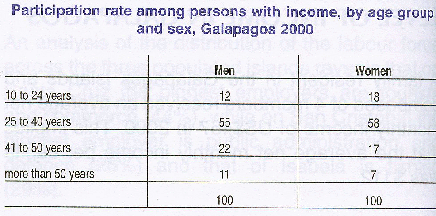
(Ruiz, 1998)
Where People Come From
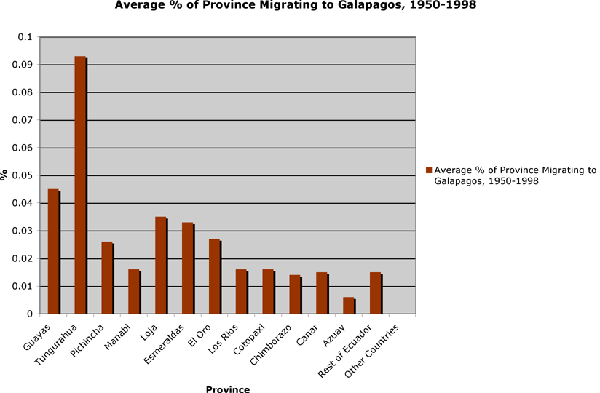
(Kerr et al., 2004)
As the graph suggests, income is significantly higher on the islands than mainland. While many of the costs of living on the islands are higher, most primary needs such as transportation of goods or people is heavily subsidized by the Ecuadorian government which in turn distorts their true cost. (MacFarland, C. & M. Cifuentes, 1996; Kerr, Cardenas, & Hendy, 2004) The following chart prepared for the Motu report provides a particularly clear overview of subsidies on the islands.
Subsidies
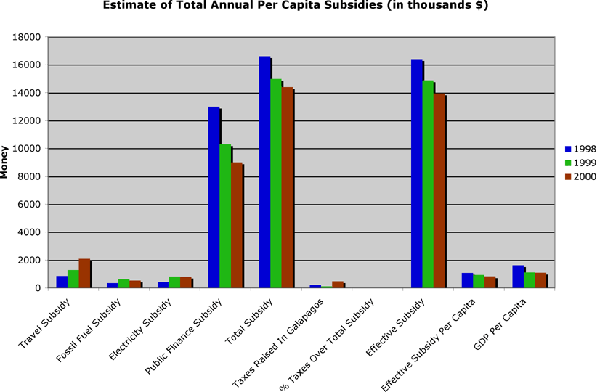
(Kerr et al., 2004)
Subsidies
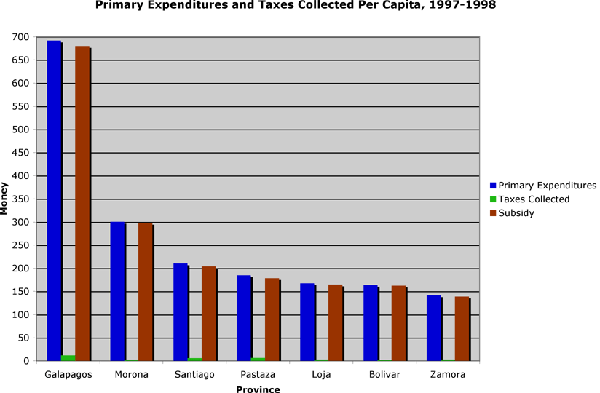
(Kerr et al., 2004)
In the following proposals, we suggest that all subsidies be re-routed to other provinces within Ecuador where the funding is more needed. In addition to these subsidies, tourist agencies and government programs recruit from the mainland which in turn unnecesarily increases migration. In each of these cases a sustainable and increasingly beneficial alternative exists.
[top]
Education
The most effective means of controlling population increase on the islands is to promote a flow of people back to the mainland. While it has been argued that there will always be more people who want to come to Galápagos than we could ever satiate, now is a better time to understand this process than later or never and some action is much better than none at all. Education is the most effective and beneficial means of inspiring this population shift. With this in mind, the first incentive we suggest to address population expansion is a series of educational incentives.
As is well articulated in the
educational proposals on this site, the current educational system is far below par. While attendance rates are very good and school facilities are available, curriculum and teacher qualifications remain poor. Those families who can afford to do so often send their children to the mainland for secondary and post secondary education, but such an action does little to address the underlying problem. When students who have finished their secondary education graduate it is rare for their background to be strong enough for them to pass entrace exams to gain admittance into a mainland university, and for those who do qualify the work load is often too difficult, which in turn prompts their return to the islands. As a result, we advocate a variety of changes to the current educational system as well as the manner in which it is structured to both address migratory pressures and more immediate understanding of just how unique an opportunity each citizen of Galápagos is given with the opportunity to live in a place as significant and fragile as Galápagos. Those directly associated with immigration will be articulated here.
The first step is to increase funding to the schools while simultaneously training locals as teachers. During this transition period, scientists working on the islands should be asked to contribute time to education as part of their standard duties, Spanish speaking tourists should be encouraged to share their native language with the locals, and the trust should provide a range of media resources for the students to use. The final curriculum should reflect Ecuadorian values and practices, teach math and science through different world wide conservation efforts, and emphasize communication as a means of inspiring change. A particularly successful example of such a program can be found in the Tibetan Children’s Village program sponsored by His Holiness the Dalai Lama. While the primary and secondary school programs are improving, it is important that the students presently of an age to begin their post-secondary education are adequately supported.
Perhaps the most inspirational educational opportunity available to the islands as a means of realizing the above vision is already in place through the program GAIAS. Co-directed by Dr. Carlos Valle and Dr. Diego Quiroga, GAIAS is currently based on San Cristobal. It is set up as a two year undergraduate program for students who have completed their secondary education, and provides an outlet for the smartest students to continue with their education on the islands. We advocate an expansion of this program as a transition point for students wishing to pursue further educational opportunities on the mainland, but as of yet unprepaired to take on the course load. Completion of this GAIAS program would qualify each student for a scholarship to a mainland university, either in Ecuador or elsewere. Broken into two categories, merit based scholarships would be provided by the hosting university and need based aid would be provided through the international trust. The current practice of teaching modular courses at GAIAS by bringing faculty from San Francisco would be encouraged. Funding would also be provided to GAIAS to allow its best students to join the international exchange programs currently in place.
It is our hope that a majority of the students who move off of the islands to pursue their education will remain on the mainland. We believe that their experiences on the island, particularly as the educational initiatives are strengthened, will serve as a phenomenal base for them to have significant impacts in the biological and earth sciences. We also expect that those most deeply committed to the islands will return bringing all that they learn with them. It is also very possible that merit based scholarships could have a requirement attached to them that their recipients return to the islands to work as educators for a year after completing their education in years where there is a shortage of educators. Again, we expect those best suited to this occupation will remain on the islands after the period of their required participation. Finally, we project that this educational initiative has the potential to significantly cut into birth rate as it draws much of the islands youth off to other places to start families. While we realize this may prompt questions of under capacity, we believe this challenge to be a more reasonable one people in policy would not be opposed to addressing if it were to become a problem.
[top]
Ties with Ecuador
The Galápagos Islands must benefit the peoples of mainland Ecuador to such a degree that the government supports the regulations it has passed in the Special Law as well as the many correlaries still under discussion. Thus, this portion of our proposal will address the question of how to make preservation in Galápagos a question of national concenus such that the general populace, and in particular its poorest quintile, does not feel that these islands no longer belong to them or bring them any benefit. To do this, we present the potential benefits of a national and international media campaign, establishing economic ties with indigenous Andean tribes, and redirecting subsidies.
As a media is an essential component of our proposal, it would take on several audiences in several forms. It would be addressed to an international audience, donor groups, other South American communities, Ecuadorian nationals, and the residents of the islands. No one strip would have a single purpose, but each would have a specific audience in mind when created. Ideally, these strips could be compiled from educational programing, in part designed by locals on the islands, and be funded jointly by foundations such as WWF and the actual filming companies. A particularly prominent and successful example of such a media campaign is that to save Tibet. While the topic in this case, particularly the human and cultural implications of the Tibet question are easier to make poignant, a similar potential lies in Galápagos.
The purpose of an international media campaign would be to unite the internaitonal community around the Galápagos question, and thus exhert pressure on Ecuador to enforce and pass environmentally sound legislation. In doing research for this project we found that very few Americans are aware that the Galápagos supports a resident population, and found this knowledge to be a factor that often inspired first a desire to learn more about the situation and subsequently to take action. We hope that such an educational campaign focused on the challenges faced jointly by the residents and the ecosystem in which they live could be used as a means of generating revenue for the trust as well as attracting larger international donors. We additionally suggest that such a campaign would help to ensure a more regular influx of ecotourism to the islands, incentivise the tour operators to run truly eco-friendly operations.
A national media campaign would be designed to instill a sense of pride in the people of Ecuador that ties them directly to their possession of th Galápagos islands. While this sentiment is an undercurrent in many realms today, little is being done to encourage it and indeed recent strikes and protests against political appointation of officals has done much to weaken the islands standing. It is essential that the unique nature of the islands and the reasons behind the restrictions in place be explained, as well as all actions taken to maximize mainland benefits from the islands in an indefinite manner. The objective of this endeavor would be less to draw funding to the islands, but alert all Ecuadorians to the value of the natural resources they posses. While Galápagos would be a key component of such a presentation, it is essential that the nation shift its attention to other environmentally sensative areas and other means of establishing a strong ecotourism based subset of the economy on the mainland.
[top]
Population Growth and Village Expansion
Villages grow. They are dynamic no matter what we do and inhibiting this change over time is an ideal way to undermine a project. Each village design we propose has room for easy expansion to a point, and a corollary that suggest means of dealing with growth that exceeds the carrying capacity of these villages as noted below. That said, land will be an absolute finite. We are not allowing the zone currently open to construction to expand, and indeed are working on expanding the capacity of the buffer zone to insulate the village. Additionally, the number of land permits presently sold in the highland villages will be frozen and incentives provided to bring those not involved with sustainable agriculture down into the three centrals towns on Santa Cruz, San Cristobal, and Isabela. We want the people to be happy. We want the town to be great. We want visitors to love it. We want the environment to prosper. We want good things, and good things are not static. If things were static, we’d not have to worry about evolution and the islands would not be near as famous as they are.
[top]
Carrying Capacity and Natural Resources
Initial population growth on the islands was curtailed by the harsh nature of island life before the tourist industry took root and brought with it energy, sanitation, and markets. It is clear that our vision for this village augments the appeal of the Galápagos when compared with the mainland. This awareness has informed two design principles that have been integrated into our village design. The first is scale and the second, as mentioned before, a high level of cooperation between struggling peoples on the mainland with the islands. It would violate our vision to purposefully design a system with flaws that in turn might disuade some individuals from trying to get to the Galápagos, indeed such flaws will simply compound the problem.
The most important resources to scale correctly are energy, imports and sanitation. An unlimited supply of any of these three will prompt growth despite legislated restrictions. To address this, in each case choices have been made to ensure that excess does not result. For example, as described in detail in the energy proposal, the generative capacity of wind turbines does an exceptional job of fitting the supply and demand levels without relying upon an extensive distribution network. Similarly, imports and exports will carry with them the cost of dispossal and their effect on the environment, as opposed to being subidized as they presently are under current policies. Our choice to use livingmachine technology was made in part to avoid the placement of a desalinization plant, something that would provide a nearly unlimited water supply. All water used on the island has a purpose and a life cycle that we have been very carefuly to respect and intrgrate into our plan.
With these factors in mind, we believe that the population limit should be set at 21,000. If this number is exceeded before proper implementation takes root, we suggest that the below mentioned option of providing residency permits to become a very real option to be used to return the population to a reasonable size over time. The land presently set aside on each island for development suggests the following local population limits: Isabela will be capped at 4,000, Santa Cruz at 5,000, and San Cristobal at 10,000.
While this value is not the carrying capacity for the islands, we believe that further growth can have no positive impact on the ecosystem. We acknowledge the global scope of this problem, and yet believe that the Galápagos unique place within the world’s ecology deserves all possible protection. On a more technical level, we believe that the following number of people are necessary to maintain the towns and villages as here discussed:
While this value is not the carrying capacity for the islands, we belive that further growth can have no positive impact on the ecosystem. We acknowledge the global scope of this problem, and yet believe tthat the Galápagos unique place within the world’s ecology deserves all possible protection. On a more technical level, we believe that the following number of people are necessary to maintain the towns and villages as here discussed:
With this in mind, there is little to be gained by trying to accommodate more people in Galápagos. Once the population max is reached and island stabilitzed we suggest that a portion of the funding flowing to the Galápagos go to the root cause of the pressures it faces, specifically the gap between rich and poor in mainland Ecuador.
This goal provides about two years to implement educational incentives and law enforcement. W. There are some physical constraints that say we can’t go on growing forever, and studies that think now might be a good time to stop. Perhaps more importantly, more people will not provide a particular benefit to the islands as there is already tremendous diversity and a near outnumbering of native Galapagans to foreigners or Ecuadorians. I am well aware that the argument, ‘curtail growth’ to fix problems is a bad one that takes a surface manifestation of a more significant problem and tries to address it on that level, but in the immediate some of this has to happen.
[top]
Permits and Taxation
Should population numbers continue to grow and migration pose a serious problem, more drastic measures certainly exist to curve such trends. Of these, the most innovative would be to institute a system where residency permits replace the current permanent and temporary residence cards. Permanent residents would be given a permanent permit but would be allowed to trade or sell this permit to anyone wishing to enter Galápagos. A set number of temporary cards would also be issued and exchanged under a similar set of guidelines. As is well articulated in the report on Migration and Environment in the Galápagos, these cards could be purchased by the municiple government currently represented by INGALA if it were ever deemed that the population was too large and then sold for profit if labor shortages were to necessitate any sort of population expansion.
As the temporary residency group is the most difficult to regulate currently, it would also be possible to place a tax or entrance fee on all individuals wishing to work on the islands. The size of this tax could be proportional to the environmental damage caused by such an individual on average and either paid by the employer or individual depending upon the situation. As a result, only people whose skills were in such demand that their job paid enough, or whose interest in the Galapagos was high enough, would be drawn to the islands, therefore creating a pool of temporary resident applications that were much more genuinely interested/invested in living in the Galapagos. This tax money could then be used for funding other environmental projects, strengthening migratory controls, or other similar projects.
[top]
Sources
- Falconí, C. (2002). Las Regulaciones Migratorias de Galápagos: Manual de Informacíon Para el Residente Insular. Trama: Quito, EC.
- Fundacion Natura, Pablo Ospina ed. (1997). Galápagos Report 1996-1997. Quito: Trama.
- Fundacion Natura, Pablo Ospina ed. (1999). Galápagos Report 1998-1999. Quito: Trama.
- Fundacion Natura (2000). Galápagos Report 1999-2000. Quito: Trama.
- Fundacion Natura, Cecilia Falconi ed. (2001). Galápagos Report 2000-2001. Quito: Trama.
- INEC (1995). Galápagos Census. Quito.
- INEC (1998). Galápagos Census. Quito.
- Kerr, S., S. Cardenas, & J. Hendy (February 2004). Migration and the Environment in the Galapagos: An analysis of economic and policy incentives driving migration, potential impacts from migration control, and potential policies to reduce migration pressure. Motu Working Paper 03-17. Motu Economic and Public Policy Research.
- Ley, Deborah. An Assessment of Energy and Water in the Galápagos, Masters Project 2001 (University of Colorado).
- Personal Communication: Dr. Carlos Valle. November 25, 2004.
[top]
Copyright!
All rights reserved.
Webmasters










